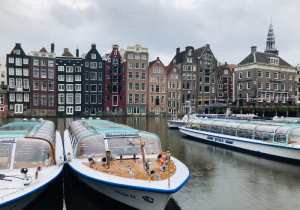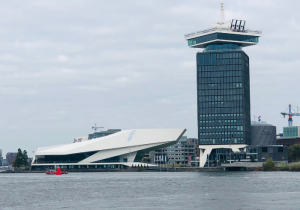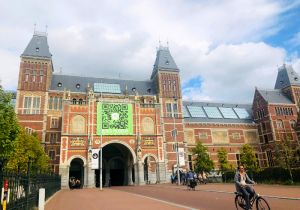At the end of the 13th century, around 700 hundred years ago, a dam was built where the Amstel River flowed into the Zuider Zee. Because of trade & fishing, Amsterdam expanded and this dam eventually grew into the port of Amsterdam. As the city kept on attracting more and more people, a wall was built around it, developing new districts at the end of the 15th century. That continued to be the case as the city keeps on growing, with seven districts and 26 neighborhoods.
 The Old Center
The Old Center
The old downtown area with the Rokin, Nieuwmarkt (New Market), the Dam and Red Light District is the oldest part of Amsterdam – with a rich history. Αt the Dam, you can see the national landmark, a white stone pillar that memorializes the victims of World War II. The Royal Palace on the Dam was built as the town hall in 1655. The Dutch royal family lives in The Hague and only uses this palace for official functions. On Dam Square you can discover the department store ‘De Bijenkorf’. Another enormous shopping territory is the Kalverstraat which runs from the Dam to Muntplein. Other intriguing spots to discover at this area are: Madame Tussauds Museum, Old Church, Begijnhof, Chinatown and Spui.
Canal Belt
The canal belt (Grachtengordel) was created in the 17th century around the old city center. Numerous excellent Canal Houses are situated on the Herengracht, Keizersgracht and Prinsengracht with average engineering for these gabled houses. In August 2010 the Amsterdam Canal belt was included as an UNESCO World Heritage site. In 2013 the waterway belt was 400 years of age. When you visit Amsterdam, a boat tour is an absolute necessity to explore and see Amsterdam. The 9 streets (de 9 straatjes) is a well known shopping area within the canal belt. Amazing, little and one of a kind boutiques, the best second hand shops, hotspot eateries and bars between the primary canals Herengracht, Keizersgracht, Prinsengracht and Singel make these cobbled paths themselves cherished by everybody. This is one of the city’s best zones to meander throughout the day. Amsterdam’s main entertainment areas are also situated in the canal belt. The Rembrandt square (Rembrandtplein) is stuffed with eateries, bars, bistros and clubs.
Each winter an ice skating rink opens. Other intriguing spots to discover with regards to this area are: Anne Frank House, Flower market, Museum Van Loon, Het Grachtenhuis (The Museum of the Amsterdam Canals), Singel 7, Westerkerk, FOAM, Museum Willet, Tassenmuseum Hendrikje and Utrechtsestraat.
 Noord
Noord
Amsterdam Noord (North Amsterdam) is a bit isolated on the other side of the center above the river IJ. There is a free ferry from Central Station that runs every five minutes to the other side. The ferry is an attraction in itself and a nice way to see (a part of) Amsterdam from the water. Amsterdam Noord is a rousing and dynamic part of Amsterdam with extraordinary design. The NDSM Wharf (‘NDSM werf’) is used as a musical festival area. The EYE Film Institute Netherlands is situated in another planned structure on the banks of the River IJ. Investigating from the downtown area, Amsterdam Noord’s most unmistakable symbol is the A’DAM Toren, a previously abandoned office square disregarding the waterway. Remaining at 100 meters, this 22-story milestone is currently furnished with a staggering housetop perception work area (A’DAM Lookout), a decision of stylish bars, clubs, and some genuinely one of a kind diners. For perhaps the best perspective on Amsterdam, take an advanced lift ride to the highest point of the A’DAM Lookout, which welcomes you to lose yourself in a 360-degree all encompassing vista of Amsterdam’s memorable focus, canals, far reaching green fields and energetic port. If you dare, you can even swing over the edge. Experience the Netherlands from an elevated view with the adjoining fascination This is Holland. Sit down for a staggering 5D flight experience over the Netherlands: smell the blossom fields, fly through the wellspring at Het Loo Palace, and appreciate the immense scenes. From the ship you can take a bicycle ride eastwards into the wonderful towns of Schellingwoude and Durgerdam. Or make a day of it and proceed onwards to other beautiful towns around the IJsselmeer lake or the UNESCO World Heritage Sites of Beemster and De Schemer. A flea market in Europe is organized once every month in the IJ-hallen (IJ-lobbies). Other similar fascinating spots to discover are: Windmill ‘D’Admiraal’ as well as various food courts with national cuisine.
Westerpark
The Westerpark territory is next to the center. There is an exceptional urban park in the previous ‘Westergasfabriek’ (Gas factory) region from the nineteenth century in this neighborhood. These days a great deal of social exercises occur after the industrial facility was relinquished in 1990. There is continually something to do in the Westerpark, because there are such a large number of bistros, hotspot eateries, a jazz club, film and a popular club. Throughout the late spring it is an extraordinary spot for relaxed picnics! It isn’t just an ideal spot to unwind in the regular environmental factors of the recreation center, yet in addition a scene for digital art and culture. Each first Sunday of the month a unique Sunday showcase takes place at the ‘Westergasfabriek’. Creators and creatives sell their exceptional items: structure, style, retro, children’s stuff, delineations, works of art, adornments, earthenware production and significantly more. ‘Westergasfabriek’ is likewise an extraordinary spot for kids. In the late spring they can appreciate a cool dunk in the enormous (normal) pool. Throughout the winter an ice skating ring is set up to coast over the ice and all through the entire year the petting zoo behind the ‘Westergasfabriek’ is open.
Jordaan
This territory was created in the seventeenth century during the huge development in the West of the canal belt (Grachtengordel), as a region for the travelers and regular workers. In the nineteenth century numerous political refugees (French Huguenots, Spanish and Portuguese Jews) discovered their home in the Jordan area, due to the low leases which prompted a populace of 80,000 people in 1900. An interesting detail on some houses in the Jordan zone is a stone sign showing the calling or family indication of the occupants. On the Rozengracht (channel), the renowned Dutch painter Rembrandt van Rijn spent the last years of his life due to the low rents. In the 20th century, after World War II, a large renovation project was started. After the project, the Jordan was discovered by a new generation: young entrepreneurs, students and artists. These days, the Jordan is an unprecedented territory to walk around the pleasant and labyrinth-like streets. Visit one of the numerous art galleries or have a beverage in one of the normal Brown bistros. Each Saturday you will discover the Lindenmarkt (a general market) on the Lindengracht and a natural food advertisement on the Noordermarkt. Mondays a flea market is open at the Noordermarkt. What’s more, remember to visit the Anne Frank House, where she lived with her family for a long time in the extension of the structure at Prinsengracht 263. Other intriguing spots to discover with regards to this area are: Amsterdam Tulip Museum, Western Church and Western Tower, Pianola Museum and Houseboat Museum.
Oud West
The Oud-West (Old West) zone is found west of the Vondelpark and is flanked in the east by the waters of Kostverlorenvaart. Oud-West is a lively multicultural zone, counting more than 170 nationalities. The Oud-West neighborhood is a clamoring blend with extraordinary feasting and shopping encounters. The Ten Katestraat is a bustling street market and is organized six days a week. Merchants sell clothing, bicycle accessories, fish, meat, cheese, vegetables, flowers and that’s only the tip of the iceberg. Another fascinating spot to visit is Hollandsche Manege. The ‘Hollandsche Manege’ arranged on the Overtoom in Oud West is enlivened by the Spanish Riding School in Vienna and was developed in 1882. It is the oldest riding school in the Netherlands. Another spot of enthusiasm is the Petting Zoo ‘Zimmerhoeve’ close to Westerpark.
 Museum Quarter
Museum Quarter
The city of Amsterdam is world famous for its museums. For art lovers, The Museum Quarter (‘Museumkwartier’) is unquestionably the spot to be in Amsterdam. The three significant and most popular museums in Amsterdam are arranged extremely close to one another. This renowned zone is home to the Van Gogh Museum, Rijksmuseum and Stedelijk Museum. Each one of the three museums are located on the Museum Square (Museumplein). Along with the world renowned Concert Hall (found south of the Museum Square), makes the Museum Quarter a genuine modern region. The primary corridor (‘Grote Zaal’) of the Concert Hall can situate up to 2.000 people and is globally perceived for its incredible acoustics. Around there, Coster Diamonds is situated too (between the Van Gogh Museum and the Rijksmuseum). It offers free guided visits demonstrating the way toward cleaning and cutting precious stones. Not a long way from the Museumplein the P.C. Hoofdstraat offers a wide scope of the world’s generally chic and restrictive design names (Louis Vuitton, Chanel, Gucci, Hermès and the sky’s the limit from there). It is one of the most costly shopping avenues in The Netherlands. Halfway situated in the city; The ‘Vondelpark’ is the biggest and most well known park in Amsterdam. It invites 10 million guests for each year with numerous vacationers and local people among them. In the mid year moving exhibitions, theater and music is played at the ‘Open Lucht Theater’ (Open Air Theater). In winter there is an incredible skating region before the Rijksmuseum.
De Pijp
South of the Canal Belt you can discover one of the most energetic zones of Amsterdam, De Pijp. This once common laborers neighborhood is home to a multicultural network with numerous stylish eateries, brown bistros and Amsterdam’s most celebrated outside market, the ‘Albert Cuypmarkt’. These days it is the home for understudies, specialists, families, youthful and elderly folks individuals and a mixture of societies and nationalities. The majority of the lanes in De Pijp are named after Dutch painters. The ‘Albert Cuypmarkt’ is the most acclaimed market in The Netherlands. This day by day market offers its products for longer than a century! The merchants (in excess of 300 slows down) sell nearly everything; cheddar, fish, meat, organic product yet additionally adornments, garments and blossoms for instance. De Pijp is likewise mainstream for its in vogue bars, Brown Cafés and ethnic eateries with credible Surinamese and Moroccan food. The previous Heineken Brewery, where the lager was fermented for 100 years, has been changed into an intelligent encounter; a visit through the dynamic universe of Heineken. It is an incredible encounter to gain proficiency with more about the historical backdrop of this well known bottling works. What’s more, obviously drink a Heineken Beer yourself toward the finish of the visit.
 De Plantage
De Plantage
De Plantage (Plantation) is a green neighborhood in Amsterdam with a rich history. De Plantage is arranged at the east end of the city. In the seventeenth century Amsterdam was one of the quickest developing and wealthiest urban communities in Europe because of its exchange abroad. The city gathering concluded that another area was important to give settlement to its developing number of occupants. Rather than building new houses, the choice was taken; residents could buy the plots and keep gardens. It turned into a green and open diversion zone and it ended up being an incredible achievement.
De Plantage turned into an extremely famous neighborhood in the nineteenth century and subsequently bars, theaters and ballrooms opened their entryways. Many wealthy Jewish citizens, entertainers and scholars moved into this territory and began to construct new great houses. Amsterdam has been one of the most noticeable Jewish centers in Europe from the seventeenth century until 1940.The city was acclaimed for its religious tolerance. In the nineteenth century the majority of the Jewish citizens settled in the Jewish quarter (‘de Jodenbuurt’), east of the Amstel River. The Jewish Quarter despite everything contains an abundance of tourist spots, markets, and significant exhibition halls: Portuguese Synagogue, Jewish Historical Museum, Resistance Museum, Dutch Theater, Rembrandthouse and Waterlooplein advertise. On Waterlooplein you can discover Amsterdam’ greatest swap meet ‘Waterloopleinmarkt’, best for recycled apparel and not a long way from the downtown area. This open air appears as though an enormous bazaar where you can purchase new stylish shirts, yet in addition vintage and retro stuff like military garbs. Not far away from the ‘Waterlooplein’ you can visit the Hermitage Museum. This is the Dutch addition of the Hermitage Museum in Saint Petersburg and is situated in a seventeenth century recorded structure on the banks of the Amstel River. Nature sweethearts can appreciate the numerous types of trees, plants and blossoms in the greenhouse, ‘Hortus Botanicus’. This is one of the most seasoned professional flower beds on the planet with in excess of 6 000 unique plants. Additionally there is Artis Royal Zoo which is substantially more than a zoo. It is the most seasoned zoo in The Netherlands with a rich history and a lovely park with old landmarks, trademark structures and unordinary gardens. What’s more, obviously you can see in excess of 900 types of creatures in Artis; from elephants, lions, gorillas, giraffes, seals, monkeys to an incredible butterfly garden. Numerous individuals visit the recreation center not exclusively to see the creatures yet additionally to have a cookout with loved ones. The ‘Tropenmuseum’ (Museum of the Tropics) is housed in one of Amsterdam’s generally lovely and biggest noteworthy structures. This is one of Europe’s driving anthropological historical centers. The assortment of the Tropenmuseum contains more than 300.000 outlandish items and authentic photographs from Asia, Oceania, Africa and Latin America.
The ‘Oosterpark’, found right behind the ‘Tropenmuseum’, is one of the biggest and greenest parks in Amsterdam. The recreation center has open spaces useful for picnics and is kept clean and tidy. Remember, The Netherlands is a nation of windmills and brew! ‘Brouwerij ‘t IJ’ (the IJ Brewery) is situated close to the ‘De Gooyer’ windmill. This little distillery was opened by a previous performer, Kaspar Peterson, in October 1985. The bottling works offers tastings and guided visits and has a huge outside patio. Different spots of enthusiasm for de Plantage are The National Maritime Museum, Science Center Nemo, Royal Theater Carré, Amsterdam Music Theater, De Magere Brug and Tattoo Museum.
